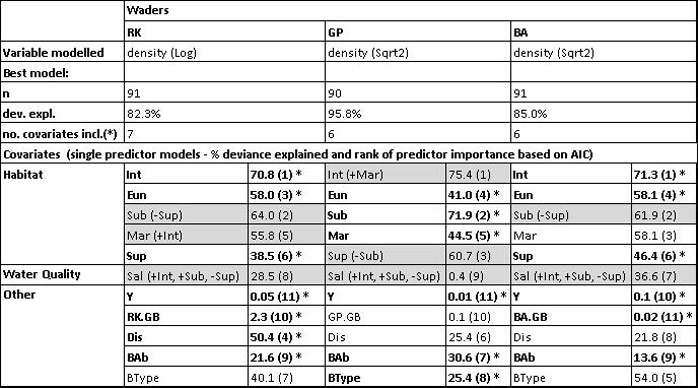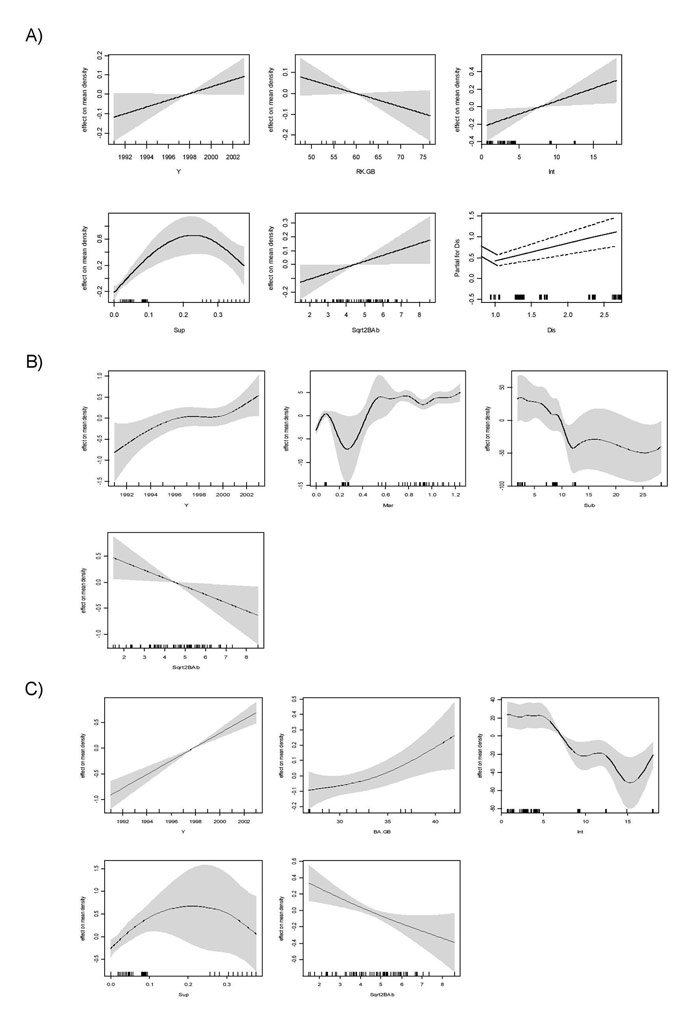

Disclaimer:
The authors are solely responsible for the content of this report. Material included herein does not represent the opinion of the European Community, and the European Community is not responsible for any use that might be made of it.
Back to overview reports
Redshank is a wader species occurring in large flocks during winter in the Humber estuary. Seven environmental variables have been selected in the final model as best predictors of its density distribution in the estuary, explaining 82% of the density data variability. The most important predictor of the density of this species is the intertidal area available within the sector, with a linear increase of the species density with this habitat area. The intertidal habitat type is also important to this species, with higher densities expected where a component of littoral sand (LSa) is present (alone or mixed with littoral mud or mixed sediments), and a linear positive relationship is also observed with the total benthic abundance (density) in the intertidal habitat, although the importance of this factor is lower than the above ones. A certain amount of supralittoral habitat (between 0.1 and 0.3 km2) in the sector is also a relevant predictor of higher densities of Redshank in the Humber, although this habitat is less important than the intertidal one. Similarly to what observed for Dunlin, an increase in Redshank density is expected in sectors where a higher disturbance index is measured. Also for this species, a relevant effect of temporal trends (measured by year) and of the wider population size on the local estuarine population is present, although these variables are the least important predictors of Redshank density among those considered in the analysis.
Golden Plover is a species regularly occurring in the Humber estuary, using estuarine areas particularly for roosting. Six environmental variables have been selected in the final model as best predictors of its density distribution in the estuarine areas, explaining 96% of the density data variability. In terms of habitat availability (area), higher densities of the species are predicted where subtidal area in the sectors is <10 km2 and marsh area is >0.6 km2, with subtidal area being the most important predictor among those included in the model. Given the positive correlation of marsh area with intertidal area in the estuary, higher density of the species would also be expected where larger intertidal mudflats occur, with the type of substratum (in particular littoral sands) in this intertidal habitat being a relevant determinant of the species density. The characteristics of the benthic resources in the intertidal habitat have also been selected as relevant predictors of the species density, with higher density where community types g and h occur (with moderate numbers of species and largely characterised by oligochaetes including Tubificoides benedii, the bivalve Macoma balthica and polychaetes such as Hediste diversicolor, Streblospio shrubsolii and Pygospio elegans) but where total benthic abundance is lower, although these two variables, together with the temporal effect of year, are the least important in affecting the species density distribution in the estuary.
Bar-tailed Godwit is long billed wader occurring regularly in the Humber estuary. Six environmental variables have been selected in the final model as best predictors of its density distribution in the estuarine areas, explaining 85% of the density data variability. The most important predictor of the density of this species is the intertidal area available within the sector, with higher density expected where intertidal area is <5 km2. The type of intertidal habitat is also important for this species, in particular where the substratum is dominated by littoral sands, whereas a negative relationship is observed with the total benthic abundance in this habitat. Also for this species, a relevant effect of temporal trends (measured by year) and of the wider population size on the local estuarine population is present, although these variables are the least important predictors of Bar-tailed Godwit density among those considered in the analysis.
Back to top
What environmental factors should be considered in the design of a compensation scheme for waterbirds and their habitats?
What environmental variables are most important in determining minimizing or basic compensatory requirements for waterbirds?
What is important in establishing a zonation for estuaries?
What tools and guidance are available to minimise and mitigate disturbance to waterbirds?
Determinants of bird habitat use in TIDE estuaries
Table of content
- 1. SUMMARY
- 2. INTRODUCTION
- 3. STRUCTURE OF THE REPORT
- 4. DATA USED
- 5. GENERAL CHARACTERISTICS OF BIRD ASSEMBLAGES IN TIDE ESTUARIES
- 6. BIRD ASSEMBLAGES DISTRIBUTION AND RELATIONSHIP WITH ENVIRONMENTAL VARIABLES
- 6a. Humber
- 6b. Weser
- 6c. Elbe
- 7. SPECIES DISTRIBUTION MODELS
- 7a. Dunlin
- 7b. Redshank, Golden Plover and Bar-tailed Godwit
- 7c. Shelduck, Pochard and Brent Goose
- 8. DISCUSSION
- 9. CONCLUSIONS
- 9a. Analysis Conclusions
- 9b. Management Recommendations
- 9c. Recommendations for Future Studies
- 10. REFERENCES
- 11. APPENDIX 1
- 12. APPENDIX 2
- 13. APPENDIX 3
- 14. APPENDIX 4
7b. Redshank, Golden Plover and Bar-tailed Godwit
The density distribution of Redshank, Golden Plover and Bar-tailed Godwit was analysed in the Humber estuary. A summary of the resulting models obtained for these species is reported in Table 6 and the shape of the effect of each selected continuous predictor variable on the model response is shown in Figure 8.Redshank is a wader species occurring in large flocks during winter in the Humber estuary. Seven environmental variables have been selected in the final model as best predictors of its density distribution in the estuary, explaining 82% of the density data variability. The most important predictor of the density of this species is the intertidal area available within the sector, with a linear increase of the species density with this habitat area. The intertidal habitat type is also important to this species, with higher densities expected where a component of littoral sand (LSa) is present (alone or mixed with littoral mud or mixed sediments), and a linear positive relationship is also observed with the total benthic abundance (density) in the intertidal habitat, although the importance of this factor is lower than the above ones. A certain amount of supralittoral habitat (between 0.1 and 0.3 km2) in the sector is also a relevant predictor of higher densities of Redshank in the Humber, although this habitat is less important than the intertidal one. Similarly to what observed for Dunlin, an increase in Redshank density is expected in sectors where a higher disturbance index is measured. Also for this species, a relevant effect of temporal trends (measured by year) and of the wider population size on the local estuarine population is present, although these variables are the least important predictors of Redshank density among those considered in the analysis.
Golden Plover is a species regularly occurring in the Humber estuary, using estuarine areas particularly for roosting. Six environmental variables have been selected in the final model as best predictors of its density distribution in the estuarine areas, explaining 96% of the density data variability. In terms of habitat availability (area), higher densities of the species are predicted where subtidal area in the sectors is <10 km2 and marsh area is >0.6 km2, with subtidal area being the most important predictor among those included in the model. Given the positive correlation of marsh area with intertidal area in the estuary, higher density of the species would also be expected where larger intertidal mudflats occur, with the type of substratum (in particular littoral sands) in this intertidal habitat being a relevant determinant of the species density. The characteristics of the benthic resources in the intertidal habitat have also been selected as relevant predictors of the species density, with higher density where community types g and h occur (with moderate numbers of species and largely characterised by oligochaetes including Tubificoides benedii, the bivalve Macoma balthica and polychaetes such as Hediste diversicolor, Streblospio shrubsolii and Pygospio elegans) but where total benthic abundance is lower, although these two variables, together with the temporal effect of year, are the least important in affecting the species density distribution in the estuary.
Bar-tailed Godwit is long billed wader occurring regularly in the Humber estuary. Six environmental variables have been selected in the final model as best predictors of its density distribution in the estuarine areas, explaining 85% of the density data variability. The most important predictor of the density of this species is the intertidal area available within the sector, with higher density expected where intertidal area is <5 km2. The type of intertidal habitat is also important for this species, in particular where the substratum is dominated by littoral sands, whereas a negative relationship is observed with the total benthic abundance in this habitat. Also for this species, a relevant effect of temporal trends (measured by year) and of the wider population size on the local estuarine population is present, although these variables are the least important predictors of Bar-tailed Godwit density among those considered in the analysis.
Important to know
Reports / Measures / Tools
| Report: | Management measures analysis and comparison |
|---|
Management issues
How can management targets and monitoring strategies be set for waterbirds in compensatory areas?What environmental factors should be considered in the design of a compensation scheme for waterbirds and their habitats?
What environmental variables are most important in determining minimizing or basic compensatory requirements for waterbirds?
What is important in establishing a zonation for estuaries?
What tools and guidance are available to minimise and mitigate disturbance to waterbirds?

